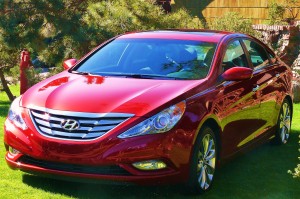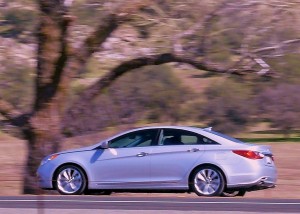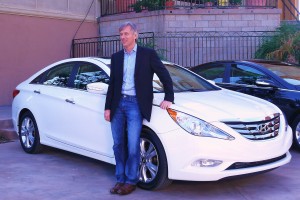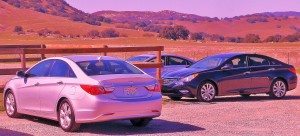2011 Sonata lifts Hyundai to midsize supremacy
SAN DIEGO, Calif. — The calendar said 2010 had a long way to go when Hyundai showed it was already soaring into 2011 when it introduced its all-new Sonata in late January, causing an unprecedented attraction for new customers to Hyundai showrooms all across the U.S.
The Sonata hit the streets in 2005, rising steadily to become a cost-effective alternative to the Honda Accord, Toyota Camry, Ford Fusion, Chevrolet Malibu, Mazda6, Nissan Altima, and whatever other nameplate you can crowd into that mainstream “midsize” form chart. With the Sonata as its primary weapon, Hyundai surprised the auto world for calendar 2009 by actually making a profit and gaining marketshare in a year when all those others suffered losses serious enough to resemble a series of mega-earthquakes that sent tremors through the industry.
Before you can say “Who are these guys?” Hyundai has unleashed the 2011 Sonata, being built in the new high-technology plant in Montgomery, Alabama. Think about it: A whole lot of good-ol’ Southerners, including rednecks, embracing a South Korean company, which is stabilizing the regional economy by building a car in a U.S. plant, using U.S. workers. Fascinating concept. But it’s only as good as the car that comes out the door, and the new Sonata is very good indeed.
In my opinion, the new Sonata is the best-looking of the whole batch of midsize cars. At a glance, it appears Hyundai kidnapped the Mercedes designer who drew up the superbly styled CLS “four-door coupe” sedan, with its sweeping, coupe-like silhouette. If the logo on the grille said Acura or Lexus, or Mercedes, it would cost twice as much. The Sonata’s slippery shape has a coefficient of drag of 0.28. Lower is more aerodynamic, anything under 0.35 is good, and 0.32 is excellent, so 0.28 is off the charts, even for a sports car.
Under that artfully-sloped body bolsters the prediction that the Sonata is an immediate favorite contender for 2011 Car of the Year. Pick whichever characteristic is most important — base price, loaded price, fuel economy, engine technology, transmission function, precise steering, sporty and agile handling, firm-but-not-harsh suspension, supportive seats, interior amenities, head and legroom, trunk space — the new Sonata has the whole package.
Competitors all start in the mid-$20,000 range, and soar to $35,000 at the drop of a nav system. By comparison, the Hyundai Sonata has three models: The GLS starts at $19,295 but is pretty well equipped, the sportier SE starts at $22,595, and the top-level, leather-clad-seat Limited starts at $25,295. True, you can add all sorts of neat features and drive those prices up, but a fully loaded Limited, with everything, including navigation system, would still be under $28,000.
The new Sonata comes only with a 4-cylinder engine. No V6 option. John Krafcik, the President and CEO of Hyundai America, explained that 88 percent of Sonata buyers choose the 4. “If 12 percent of the buyers buy V6es, then the other 88 percent have to have the heft of a platform built to house the V6,” said Krafcik. In contrast, designing the platform around only the 4 means the new Sonata could be tighter, leaner, stronger, and safer, from a construction standpoint. Even a brief drive in the new Sonata is convincing about the unified feel and the potency of the engine’s advanced design.
The Theta II GDI engine has all the latest high-tech tricks. Not only does it have dual overhead camshafts and four valves per cylinder, but it adds dual variable valve-timing, and gas direct-injection, which sends those dished pistons churning with impressive results. All those top competitors have 4-cylinder engines measuring either 2.4 or 2.5 liters, and all are DOHC designs. But direct injection lifts the Sonata to 198 horsepower and 184 foot-pounds of torque. By comparison, the Accord’s 2.4 has 177 horsepower/161 foot-pounds of torque; the Altima’s 2.5 has 175/180; the Fusion (and Mazda6) 2.5 has 175/172; the Camry’s 2.5 has 169/167; and the Malibu’s 2.4 has 169/160.
For those questioning Hyundai’s technology, Exhibit A is a horsepower edge that ranges from 21 horses over the runner-up Accord to 29 over the Camry and Malibu, and Exhibit B is the torque edge ranging from 4 more foot-pounds than the runner-up Altima to 24 better than the Malibu. For good measure, the SE model of the Sonata goes slightly upward, to 198 horses and 184 foot-pounds.
If you’re looking for Exhibit C, the Sonata has EPA fuel economy figures of 22 city and 35 miles per gallon highway for the automatic, and 24/ 35 with the manual. All the 4-cylinder models in the midsize class have good EPA numbers, ranging from a low of 22 in city driving for all but the Altima’s 23, up to a high of 35 — by the Sonata — on the highway cycle. Other highway EPAs show the Accord and Fusion at 31 with automatics, the Camry and Malibu 33 each, and the Fusion 34 with the stick.
In real-world driving, however, there is reason to believe the Sonata will expand its edge substantially, leading to Exhibit D. Krafcik, a sharp-witted, clever, and candid fellow who has bold ideas and carries them out, discussed the vagaries of EPA estimates with me a couple years ago. I mentioned how some companies make engines with good fuel economy, others have trouble approaching their EPA estimates, and still others hide behind impossible-to-achieve EPA numbers and refuse to even discuss “real world” gas mileage, which might be significantly less. Krafcik said: “Now that we’ve gotten our EPA fuel economy numbers up where we want them, our next objective is to make our real-world gas mileage the best, too.”
After his minions set up the mountain roadways near San Diego for the media test drives, Krafcik drove a new Sonata over the route and got remarkably good gas mileage, prompting him to challenge the media members to spend part of the drive enjoying the curvy mountain roads and the car’s performance, up to and past the Julian Pie Shop, and then to strive to see who could get the best fuel economy on the return route, from the South Coast Winery to Torrey Pines hotel.
Being a gas-mileage zealot, I set the on-board computer on the curvy part, as well, and got 38.3 miles per gallon. Very impressive. On the return, much of the 60.3 miles was freeway, and I was driving with a Hyundai engineer who also was a hockey fan. We got engrossed in great conversation, about Herb Brooks, and a book I’ve written about his coaching career, and comparing the Olympics then and now. All of a sudden, as we approached Exit 27, he said: “Oops! We were supposed to turn on Exit 19.”
Not a problem. We cut across the countryside and got there, in plenty of time. I enjoy mileage tests, but not the “hyper-mileage” tricks of extremely slow and bothersome speeds. I attempted to draft behind a large, square-back semi part of the way, but I did maintain the speed limits rather than driving super-slow just for economy. I averaged 46.8 miles per gallon, and I was amazed. When we heard the winning tandem recorded 52.8 miles per gallon, and second best was 49.0, we accused them of going 40 miles per hour on the shoulder.
Flashing back to EPA estimates, Hyundai now averages 30.1 miles per gallon for its entire fleet. Honda is second best at 29.7, Volkswagen 29.6, and Toyota 29.4. But Hyundai is the only manufacturer to have a corporate average over 30 miles per gallon. And when you consider that the Sonata so easily topped its 35-mpg EPA highway estimate, and so readily could attain 40-plus, you realize technology has allowed Krafcik’s vow to blossom.
In overall length, the Sonata is 189.8 inches, while the Camry is 189.2, the Fusion 190.6, Altima 190.7, Malibu 191.8, the Mazda6 193.7, and the Accord 194.1. Interestingly, though, the Sonata has a total interior volume of 120.2 cubic feet, while the Accord has 120.0; those are the only two in the class that meet large-car interior limits, while the rest are properly midsize, as the Fusion lists 116.8, the Camry 116.4, the Altima 116.0, and the Malibu 112.8. The Sonata’s mix shows passenger volume of 103.8, where only the Accord’s 106.0 tops it, and a cargo volume of 16.4 cubic feet, where only the Fusion’s 16.5 beats it. The Accord, with top passenger volume, has the least cargo volume in the class at 14.0.
The Sonata weighs only 3,161 pounds with a 6-speed manual — yes, a stick-shift! — while with a 6-speed automatic, the Sonata weighs a still-svelte 3,199 pounds. The Altima, at 3,180 pounds, is the only one lighter, while, for example, the Accord is 3,269, the Camry 3,307, the Fusion 3,342, and the Malibu 3,415.
Combining more power — from technical advances, not enlarged displacement — with lighter weight gives the Sonata a clearcut edge in acceleration. But its handling is also impressive. With strut front and multi-link rear suspension, the SE model has 23-percent firmer front and 8 percent firmer rear shocks, with a 13-percent larger rear stabilizer bar. That helps adroit handling, and the steering and design give the Sonata a 35.8-foot turning radius. Comparatively, the Camry and Altima need 36.1 feet, the Fusion 37.5, the Accord 37.7, and the Malibu 40.4 feet. Which do you like for a U-turn?
It is neat that the Sonata can be obtained with a 6-speed stick, but its new Shiftronic automatic is also a 6-speed, and Exhibit D is that the unit is Hyundai’s own transmission, making Hyundai one of only three automakers to have invented their own proprietary 6-speed automatics. A manual shift gate on the shift lever is augmented by steering wheel paddles on the SE models for manual control of the automatic. It took four years of development, and the 6-speed automatic is 26.5 pounds lighter than the 5-speed unit it replaces, and it also is shorter and has 62 fewer moving parts.
Hyundai — which only started assembling other company’s cars in the late 1960s and didn’t build its own vehicles until the 1990s — has made up a couple of decades of ground on long-term rivals in the past couple of years. The 2.4 engine lifts the company’s engineers to a higher plane, and they followed up with the superb DOHC V8 that propelled the large Genesis to 2009 Car of the Year honors. They next refined their V6, then came back and improved the 2.4, adding a high-pressure direct injection system. Meanwhile, at the New York Auto Show in the spring, Hyundai unveiled two more models to the still-new 2011 Sonata, one a 2.0-liter 4-cylinder turbo sporty model, the other a hybrid built entirely with Hyundai technology.
Back to Krafcik, who might be classified as a slice of 8-grain bread with lots of nuts and seeds, in a world of white-bread auto executives who seem to be alternatingly defending their losses and creating illusions about hopes for the future. Krafcik inspired my bread analogy with a comment at the introduction of the Sonata.
“Our success in 2009 was the culmination of a lot of hard work,” Krafcik said. “When the economy is hurting, people do more research and put more effort in deciding on their choices. That helps us. We brought out the 2011 Sonata with some Super Bowl ads, and they worked well, especially for a brand like ours, where our image hasn’t caught up with our capabilities. The Sonata is in the ‘white bread’ segment, and we have three objectives: We want to be a rational choice, we want to lead the way in being environmentally friendly, and we want to make an emotional connection.”
With such features as side-impact airbags and stability control standard, and a transferable powertrain warranty of 10 years or 100,000 miles, Hyundai has taken care of rational consideration. As for depreciation and residual value, Hyundai now is better than Toyota or Ford. For residual value, the Accord retains 54 percent of its value after three years, with the Sonata second at 53 percent, followed by the Altima 51 percent, Camry and Fusion at 49 percent, and Malibu at 46 percent. And that is not considering the new 2011 Sonata, with all its improvements.
Two or three years ago, I was reluctant to recommend a Korean car to anyone who asked my advice. Improved though they were, they were still in formative form against the slick Japanese, the potent Germans, and even the U.S., bent as some manufacturers seemed to be on self-destruction from varying doses of arrogance and complacency. The Fusion won 2010 Car of the Year in hybrid form, the Mazda6 has risen to sporty styling heights, the Malibu has improved in current form, and the Altima, Accord and Camry all are larger and their usual solid selves. But right now, I would insist that any serious buyer comparison shop the 2011 Hyundai Sonata.
Badgers rise to playoff peak in time for Frozen Four
 In the moments after Wisconsin won a tough and challenging West Regional championship, Badgers coach Mike Eaves could pause and wonder what happened to sidetrack Denver and North Dakota on their way to their appointed spots at the Frozen Four.
In the moments after Wisconsin won a tough and challenging West Regional championship, Badgers coach Mike Eaves could pause and wonder what happened to sidetrack Denver and North Dakota on their way to their appointed spots at the Frozen Four.
While he may have been puzzled that WCHA regular-season champion Denver and WCHA playoff champion North Dakota had both lost in other regionals, Eaves is a master pragmatist, capable of focusing on things that might be within his control. At that moment, satisfaction at having beaten Vermont, then reversing a league playoff loss to St. Cloud State was foremost. It earned the West Regional’s berth in the April 8-10 Frozen Four in Detroit, which now becomes something that might fall into that controllable category.
No. 2 ranked Wisconsin (27-10-4) faces RIT (28-11-1) in the 4 p.m. (CDT) first semifinal, with No. 1 Miami of Ohio (29-7-7) taking on Boston College (27-10-3) in the 7:30 p.m. second semifinal, with both games on ESPN2. The winners play at 6 p.m. Saturday, on ESPN.
“We’re blessed to have some awfully talented young men on this team, with a tremendous work ethic,” said Eaves. “They are selfless, capable of focusing on the team, and all things have come together for us at the right time. Last year, we were .02 points away from making the [NCAA] playoffs. That has been on our kids minds; we even had t-shirts made up.”
The Badgers, who finished second to Denver in league play, had to lift themselves up after reaching the Final Five, where they were blanked 2-0 by St. Cloud State in the semifinals. They rebounded the next day to beat Denver. As the No. 1 seed at the West Regional, Wisconsin beat Vermont before coming back with force to avenge that setback to St. Cloud State in the West Regional final.
“There was a lot of redemption for us [against St. Cloud State],” said junior defenseman Ryan McDonagh. “We didn’t play well last weekend [in the Final Five], and we knew what was riding on the game this time — going to the Frozen Four.”
Now Wisconsin faces the peculiar venue of playing the Frozen Four at Ford Field in Detroit — the Lions NFL stadium, which could produce record hockey tournament crowds. In that regard, the Badgers have the experience of having played in a football stadium already this season, having played and beaten Michigan 3-2 at Camp Randall Stadium, before 55,031 — a number that might be difficult to top in Detroit, with both Michigan and Michigan State conspicuous by their absence.
Boston College also played at Fenway Park on January 8, losing 3-2 to Boston University before 38,472 fans. Big-stadium experience notwithstanding, Wisconsin will make a formidible entry in the Frozen Four, with an overpowering defense, and a surprisingly unheralded scoring attack. The large, hard-hitting, and mobile defense, with five first- or second-round NHL draftees and a sixth who is certain to be drafted this year, are Wisconsin’s most evident asset.
An NHL expansion team would thrive with a defense that included juniors Ryan McDonagh, taken in the first round by Montreal in 2007; Brendan Smith, taken on the same first round by Detroit; and Cody Goloubel, taken on the second round in 2008 by Columbus; plus sophomore Jake Gardiner, a 2008 first-rounder by Anaheim; and freshman Justin Schultz, a 2008 second-round pick of Anaheim. That leaves only John Ramage, who started the season as an 18-year-old freshman from St. Louis. He’s the son of Rob Ramage, a 16-year NHL defenseman who was a first-round pick of Colorado in the 1979 expansion draft.
But don’t underestimate the forwards. Most notable up front has been captain and first-line center Blake Geoffrion, the lanky, 6-foot-2 grandson of Bernie (Boom-Boom) Geoffrion. With his hometown listed as Brentwood, Tenn., Geoffrion is undoubtedly going to be the first home-state performer for the Nashville Predators, who drafted Geoffrion on the second round. A key to the Badger season was when Geoffrion turned down th eoffer and decided to play his senior season at Wisconsin.
“We don’t have the team we have without Blake coming back,” said Eaves, matter-of-factly.
Geoffrion led the WCHA in conference scoring until the final day, when Denver’s Rhett Rakhshani slipped ahead — 15-20–35 to 19-15–34. But a funny thing happened to the team scoring lead in the playoffs. Geoffrion had a goal and an assist in the 3-2 West Regional victory over Vermont, and added a goal and two assists in the 5-3 victory over St. Cloud State, his overall total of 27-21–48 is impressive, and helped him win West Regional most valuable player status — but his points rank only third-best on the Badger team.
Senior Michael Davies has 19-32–51, and sophomore Derek Stepan has 10-40–50 to rank 1-2 on the Wisconsin team in all games. Junior defenseman Brendan Smith has 15-32–47 to rank one point behind Geoffrion’s total. Geoffrion is best with 14 power-play goals, while Stepan leads all league scorers with his 40 assists, while Davies and Smith — the league’s top-scoring defenseman — are tied for second best with 32.
“Our seniors have worked ever since our freshman year,” said Geoffrion. “It’s an incredible feeling to get to the Frozen Four.”
Then he pointed to “Mitchie” — John Mitchell, a 6-foot-5 crusher who scored twice in the region final. He had only five goals all season until adding those two. Mitchell, in turn, gave credit to the penalty-killers for stopping all seven Huskies power plays, and it’s understandable, because that’s a group he not only appreciates, but also personally gives them a lot of action.
{IMG2}
“Our PK did a tremendous job,” said Mitchell. “I got five penalties in the two games [of the West Regional], and I think I’m going to have to limit those penalties.”
As for contributions from players like Mitchell — a free-agent senior who might also earn a lot of attention from NHL scouts after the season — Eaves, who has had numerous teams that had difficulty scoring and had to rely on defense and goaltending to survive.
“At this point, we’re looking for offense from anybody,” Eaves said. “And Mitch was very effective for us this weekend.”
As a further example of how this team has developed and matured, Eaves singled out another senior, and said: “Look at Aaron Bendickson. He had a great chance with an open net, but he bounced it off the post. He came back after that and played like he was possessed, and he wound up getting a goal. I’m not sure he would have reacted the same way at the start of the season, but that’s how focused we are now.”
The added burden carried by the Badgers into the Frozen Four will be shrugged off with two Wisconsin victories. But the league’s opportunity to get three teams to the Frozen Four seemed like the most lucrative since 2005, when Denver, North Dakota, Minnesota and Colorado College filled all four slots at the Frozen Four in Cincinnati, with Denver winning. Such success leads to questions about parity. Did the fact that WCHA champion Denver was upset 2-1 by Rochester Institute of Technology, and that WCHA playoff champion North Dakota had been upset 3-2 by Yale, mean that the proud Western Collegiate Hockey Association might not be as strong as we in the west would like to believe?
After all, while no other league can approach the 36 NCAA championships won by teams from the WCHA. And close followers of the annual league race and the spectacle of the WCHA’s playoff structure, resulting in the flashy Final Five tournament at Xcel Energy Center in St. Paul, can look with pride at the listing of years WCHA teams won those titles. It does appear, however, that someone hasn’t been keeping that list up to date, because after it shows “…1997, 2000, 2002, 2003, 2004, 2005, 2006…” there aren’t any more years listed. What happened to 2007, 2008, and 2009?
Correct. The proud WCHA, which won so regularly that in 2005 Denver, North Dakota, Colorado College and Minnesota made it an all-WCHA Frozen Four, and which won five consecutive NCAA titles up through 2006, hasn’t won since.
That, of course, isn’t a problem for the Badgers. They won that 2006 title, and while they might prefer to see some familiar WCHA faces across the rink, their only challenge is to be ready to win two games and recapture the title for the WCHA.
WCHA bids 4 aces into NCAA puck tournament
 Can North Dakota maintain its hot streak? Can Denver recover from losing two straight for the first time all season? Can Wisconsin channel its consistency into sudden-death mode? And can St. Cloud State turn its back on its curious 0-forever NCAA record?
Can North Dakota maintain its hot streak? Can Denver recover from losing two straight for the first time all season? Can Wisconsin channel its consistency into sudden-death mode? And can St. Cloud State turn its back on its curious 0-forever NCAA record?
All are valid questions awaiting those four WCHA teams, all of which earned slots in this weekend’s NCAA regional hockey tournaments. At stake in the four regionals are opportunities to go to Detroit on April 8-10 to take part in the Frozen Four, in hopes of becoming the 37th WCHA team to win a national championship since the league was organized in 1951. It would, however, be the first WCHA national champ in four years, because, in a rarity, no WCHA team reached the final game the last three years.
The WCHA Final Five tournament is such a taxing and emotional event that perhaps it has become a challenge to maintain or reacquire momentum or flow from the Final Five to the NCAA tournament. This would seem to be the ideal opportunity for the WCHA to regain its stature, with four of the 16 NCAA entries.
The prime opportunity would seem to come in the West Regional at Xcel Center in St. Paul, where Wisconsin (25-10-4) is the No. 1 seed and will face No. 4 Vermont (17-14-7) in the 8 p.m. (CDT) Friday semifinal, after St. Cloud State (23-13-5) rides the No. 2 seed against No. 3 Northern Michigan 20-12-8) IN THE 4:30 game. Those winners meet Saturday at 8 p.m. for the West Regional title. An all-WCHA final, between Wisconsin and St. Cloud State, is certainly feasible, as the two teams are returning to the scene of the Final Five, where the Huskies topped the Badgers 2-0 in the semifinals.
League champion Denver (27-9-4) is the No. 1 seed in the East Regional at Albany, N.Y., where the Pioneers face Rochester Institute of Technology (26-11-1) at 2 p.m. Friday, followed by No. 2 seed Cornell (21-8-4) against No. 3 New Hampshire (17-13-7) in the 5:30 p.m. second game. Those winners will decide the Frozen Four entry at 5:30 p.m. Saturday.
Denver proved its superiority in winning the league title, behind goaltending champ Marc Cheverie, and league scoring champ Rhett Rakhshani, but the Pioneers have to try to get back in proper rhythm after losing both games — to North Dakota and Wisconsin — at the Final Five. Snapping back into form is not automatic.
North Dakota (25-12-5), riding a hot streak that includes a three-game surge to the Final Five’s Broadmoor Trophy, heads east also, where it will be the No. 2 seed in the Northeast Regional at Worcester, Mass., taking on No. 3 Yale (20-9-3) at 4 p.m. Saturday, preceded by a 12:30 p.m. match between No. 1 seeded Boston College (25-10-3) and fourth-seeded Alaska Fairbanks (18-11-9). Those winners collide Sunday at 4:30 p.m.
North Dakota is riding a hot streak of 12 victories in 13 games, with junior Evan Trupp contributing the latest hot hand. Trupp scored the clinching goal in the 2-0 victory over UMD to open the Final Five, then added two goals and assisted on the winner in the 4-3 victory over top-seeded Denver in the semifinals, and assisted on both goals when the Sioux countered from a 2-0 deficit against St. Cloud State and went on to a 5-3 victory for the Final Five title. Trupp, who came into the Final Five with 5-23–28, added 3-3–6 out of the first eight goals scored by the Sioux at Xcel Center.
The Midwest Regional at Fort Wayne, Ind., is the only one without a WCHA team, although it does have Bemidji State, which will be joining the WCHA next season. The Beavers (23-9-4) rate the No. 2 seed and will face Michigan (25-17-1) at 6:30 p.m. Saturday, following the 3 p.m. game between Miami of Ohio (27-7-7), the No. 1 seed overall, and No. 4 seed Alabama-Huntsville (12-17-3). Huntsville earned the slot after Niagara upset Bemidji State by beating Niagara in the College Hockey America final. That outcome, combined with Michigan’s upset of Miami and victory over Northern Michigan to win the CCHA’s automatic berth, conspired to bump Minnesota Duluth out of the 16-team field, or the WCHA would have had five entries.
An interesting aside is that Denver had never lost two games in succession all season, but was stung by North Dakota 4-3 in the WCHA semifinals, then also lost to Wisconsin 6-3 in the third-place game. The question facing the Pioneers is that those losses are meaningless if they regain their touch — unless they find it difficult to get back into their impressive form. It doesn’t help the Pioneers that Anthony Maiani, top scorer after the Rhett Rakhshani-Tyler Ruegsegger-Joe Colborne line, is out after being injured against North Dakota.
Wisconsin also has an impressive run of having not lost two in a row all season, a record the Badgers extended by beating Denver 6-3 in the third-place game after losing 2-0 to St. Cloud State in the semifinals of the WCHA Final Five. In that game, the Huskies lost Garrett Roe, their offensive co-leader with Ryan Lasch, when he slid into the boards trying to block a shot. Roe missed the 5-3 title loss to North Dakota, but will be back for the West Regional.
“He was more hurt than injured,” said St. Cloud State coach Bob Motzko after Thursday’s practice at Xcel Center. “He’ll be back, although he might have a sore neck.
“We’re playing well as a team, and we’re doing that the best we’ve done right now,” Motzko added. “I think we just have to keep chugging along. I’ve really liked our team from the start, and we’ve had a couple of good runs, and a couple of pops in the nose.”
The worst of those pops was an 8-1 loss to North Dakota in St. Cloud, but the Huskies responded by going to Wisconsin to win their next game 5-1. “We’ve had real battles through the playoffs,” Motzko said. “First we had to battle to beat Mankato in the best-of-three, then we had a great battle with Wisconsin, and then a great game against North Dakota.
“We went to Miami to open the season, and we lost two tough games, but we haven’t been swept since. When all else is equal, everything comes back to our penalty-killing. When we’re aggressive, we’re good killing penalties, but we gave up three poer-play goals against North Dakota. I’d have to say, though, that for 12-14 minutes of that game, North Dakota played great and put us back on our heels.”
The other thing the Huskies have going for them, when all else is equal, is the penchant for timely scoring from Roe and Lasch, both of whom have scored 19 goals, 27 assists, for 46 points. Penalty killing is vital, but so is the ability to generate scoring.
The Huskies also have something of a large hurdle to overcome, although Motzko points out that such history means nothing to the current crop of players. But this is the eighth time St. Cloud State has reached the NCAA tournament — third under Motzko — and the Huskies have yet to win their first regional game. It also is the first time the Huskies have been able to play in the West Regional, where the familiar Xcel Energy ice sheet should be surrounded by Huskies fans.
For now, Northern Michigan consumes the attention of Motzko and his Huskies. If they win, they can start worrying about Wisconsin — or Vermont. But that doesn’t prevent Motzko from seeing strong potential from WCHA teams at this year’s tournament.
“Our four teams that are in right now — all four — are playing their best right now,” said Motzko. “And I think any of the four have a good chance to win.”
UMD wins 3OT thriller for 5th NCAA women’s title
 MINNEAPOLIS, MN. — While Jessica Wong may be only a freshman at the University of Minnesota-Duluth, she already has established a tendency to score huge goals. But she may never score a bigger one than she scored Sunday afternoon, when she deflected a Tara Gray shot into the Cornell goal at 19:26 of the third 20-minute overtime period to lift UMD to a 3-2 victory in the NCAA Women’s Frozen Four championship game.
MINNEAPOLIS, MN. — While Jessica Wong may be only a freshman at the University of Minnesota-Duluth, she already has established a tendency to score huge goals. But she may never score a bigger one than she scored Sunday afternoon, when she deflected a Tara Gray shot into the Cornell goal at 19:26 of the third 20-minute overtime period to lift UMD to a 3-2 victory in the NCAA Women’s Frozen Four championship game.
It was the longest game in NCAA Frozen Four history, surpassing the 2003 title game that UMD won by beating Harvard 4-3 at 4:19 of the second sudden-death overtime, at the DECC in Duluth. But this one, before 1,473 fans at Ridder Arena, may be a difficult record to surpass — it was only 26.4 seconds short of being two complete games.
Wong, who registered 15 goals for her freshman season, scored the first one when UMD beat Minnesota 3-2 for the WCHA Final Faceoff title, and she has since refined her art, scoring the game-winner in the 2-1 quarterfinal victory over New Hampshire, and now notching the goal that ended women’s Frozen Four’s longest game.
UMD finishes 31-8-2, having won its last nine games, and recorded a stunning 18-1 record since December 4. The Bulldogs managed to outshoot Cornell (21-9-6) by a 36-21 margin in the three overtimes, and 64-51 for the extremely close, up-and-down game, to claim a record fifth national championship — exactly half of the 10 NCAA sanctioned women’s national tournaments held. The Bulldogs won the first, second and third NCAA titles, in their first four years as a Division I program and came back to win again in 2008.
Three championships by Wisconsin and two by Minnesota mean that all 10 NCAA trophies belong to those three WCHA schools. Coach Shannon Miller said this one stands above all the others, which were won by exceptional teams that often overran foes with great talent, because this team was a youthful underdog from the start, rising to championship glory as eight freshman regulars improved dramatically.
“I told the players this was the most special team I’ve ever coached,” said Miller, who also predicted to a staff member between overtimes that she figured Wong would score the winner. “I thought getting into the top eight in the country, and staying there, would be a great goal. And if we could make the NCAA field, we’re really good in one game. We’ve upset good teams all season.
“I know Cornell had never been to ‘the dance’ before, but we’re the Cinderella story this year. With five Olympians gone from our team, we’re playing with 13 scholarship players against teams that have 18.”
Cornell had three freshmen playing compared to UMD’s eight, but the Bulldog freshmen gave UMD enough depth to skate a third line when it got to overtime, and wear down the Big Red, which relied almost completely on two forward lines. Cornell, which upset No., 1 Mercyhurst 3-2 on Friday, while UMD was beating Minnesota by the same 3-2 score, played an outstanding game in turning its first attempt at the Frozen Four into a quest to knock off the two top-rated teams in the country back-to-back.
“It was a great game, and I want to congratulate Shannon and Minnesota-Duluth,” said Cornell coach Doug Derraugh. “I’m also very plesed with my team. We’ve had a blast here, and I played 14 yearrs of pro hockey, but I’ve never been prouder of a team or seen a team with more heart.”
In fact, the Big Red struck first, when Melanie Jue got her first of two goals, tipping Lauriane Rougeau’s shot from the right point past Jennifer Harss, UMD’s freshman goaltender. That goal didn’t come until 13:44 of the second period, during an extended Cornell power play, and the 1-0 lead stood until the third period began.
With UMD on a carryover power play, Emmanuelle Blais rushed form the left for a shot that was blocked, but she followed up with another shot to beat Amanda Mazzotta in the Cornell goal at 0:18. The goal was the 32nd of an astounding season for Blais, one of only four UMD seniors. She ended with 32-33—64 for the season, with a finishing flourish of six goals and six assists in her last five games — good enough to earn her the most valuable player award at the NCAA Frozen Four, duplicating the award she also won it at the WCHA Final Faceoff tournament, and first-team All-America status.
“When we won the WCHA playoffs and I got the MVP, I obviously was happy, and now this,” said Blais. “But I am focused so much on my team. This has been the best year of my life.”
With six minutes remaining, two of the other UMD seniors connected, when Saara Tuominen had the puck in deep on the right side and spotted defenseman Jaime Rasmussen breaking for the net from the left point. “I know Jaime is offensive, and would be going to the net,” said Tuominen. “I had time to see her.” She also delivered a perfect pass, and Rasmussen, a right-handed shooter, drilled her shot from the left circle at 14:42.
The 2-1 lead may have swept over the Bulldogs, knowing there was only 5:18 remaining between them and their record fifth championship, but it didn’t fool Miller. “When it’s for the national championship, and you’re leading by one goal, you anticipate a tie,” said Miller. “It takes mental toughness, and it’s nothing new for us, but Cornell was absolutely amazing, and they also had a great will to win.”
Sure enough, with 3:30 remaining, the Big Red tied the game 2-2 when a shot that bounced off the right pipe and the carom went directly to Jue, who put away a backhander from the right circle.
“Jue has come up with a lot of big goals,” said Cornell coach Doug Darraugh. “…Probably none bigger than tonight.”
{IMG2}
Cornell, led by senior center Catherine White, traded rushes with the speedy Bulldogs throughout the game, and had a 30-28 edge in shots when the third period ended. UMD had a slight edge, at 12-11, through the first overtime, then outshot the Big Red 10-4 in the second overtime, and 14-6 in the third. A pivotal difference was when Miller went from matching two lines against Cornell’s two lines to inserting the third line of Gina Dodge between fellow-freshman Vanessa Thibault and hustling sophomore Kacy Ambroz.
“I gave them a clear job, to be good defensively on a very short shift, get the puck over the red line and get it in deep,” said Miller. “Then I told them, ‘OK, that was perfect,’ and I gave them longer shifts.”
Her players appreciated it. “I always want more ice time, but I was ready to be done,” said Blais, who scored two goals and set up Laura Fridfinnson for the third in Friday’s 3-2 semifinal victory over Minnesota. “Thibault, Dodge and Ambroz gave us a tremendous lift, and I think that was a key in the game.”
Still, nothing was decided as the game went through the first, then the second, and deep into the third overtime. Lauriane Rougeau prevented a goal when she took down Fridfinnson to halt a breakaway, but she was penalized at 17:20. She came out of the penalty box and skated across the ice to the bench when UMD’s Mariia Posa worked the puck to Gray at the right point — 10 feet from the Cornell bench. “I saw her coming across the ice trying to get a change, and she got her stick under [Gray’s] stick as she shot,” said Derraugh.
As Rougeau fell, she nearly smothered the puck, but Gray got most of her force on the shot and sent it on net. Blais and Wong were in front, and said, “We had a double screen, and I was saying to myself, ‘Tara, shoot the puck!’ ” said Wong, who earlier in overtime had shot one off the crossbar. This time, she didn’t miss. “I saw it coming all the way, and I got a piece of it with my stick blade.”
The deflection went down and between the leg pads of Mazzotta. The clock showed “0:33.6” remaining, and UMD skated into NCAA hockey history.
Sioux sweep UMD, Denver, St. Cloud to win Final Five
 SAINT PAUL, MN. — A year ago, it seemed impossible for any team to survive three games in three days to win the WCHA Final Five championship. As of Saturday night, it seems to be a new trend, as North Dakota toppled St. Cloud State 5-3 before 16,414 fans at Xcel Energy Center to become the second team in a row to capture the league playoff trophy with three victories.
SAINT PAUL, MN. — A year ago, it seemed impossible for any team to survive three games in three days to win the WCHA Final Five championship. As of Saturday night, it seems to be a new trend, as North Dakota toppled St. Cloud State 5-3 before 16,414 fans at Xcel Energy Center to become the second team in a row to capture the league playoff trophy with three victories.
North Dakota beat Minnesota-Duluth 2-0 on Thursday, then knocked off No. 1 ranked Denver 4-3 Friday, but had to rally from behind after spotting St. Cloud State a pair of goals in the first minute of the title game. The Fighting Sioux never lost their focus, and simply turned up their pace and responded with four unanswered goals to take command of the game. The Huskies rallied and threatened until the finish, but were finally outdistanced by an empty-net goal in the final minute.
Last year, Minnesota-Duluth became the first team to ever rise from the Thursday night “play-in” game to win the tournament.
“Minnesota-Duluth proved it could be done last year with a great run,” said Fighting Sioux coach Dave Hakstol. “Three games in a row is tough, but we’ve come to the Final Five many years and it’s always tough. The gas level was not going to be an issue tonight. I didn’t think we had any trouble with energy until late in the third period, and maybe in the third. But we had an extra man on the ice all weekend with the Fighting Sioux fans.”
The Sioux fans seemed to have the building surrounded, outshouting the other four teams’ followers. With the victory, North Dakota overran their own No. 4 tournament seeding by extending their hot streak to 12 victories in their last 13 games, rising. Now 25-12-5, North Dakota and St. Cllud State (23-13-5) were both already assured of joining Denver and Wisconsin to give the WCHA four teams in the NCAA tournament.
The Huskies couldn’t have had a better start, jumping ahead 2-0 in the first minute. Goaltender Brad Eidsness, a strong point for North Dakota all season, was victimized at 0:40 by Garrett Raboin, who scored after Ryan Lasch circled out from behind the net and got the puck to the slot. The assist gave Lasch his 184th career point for the Huskies, breaking Jeff Saterdalen’s all-time school record. The Huskies fans were still cheering for the 1-0 lead when, at 0:55, David Eddy scored jhis first of two goals from the right side after Drew LeBlanc’s pass across the slot.
“We came out quick, but they fought back and controlled play there for a lot of the game,” said Raboin. “For them to play three straight days again, the way we both did last weekend, says a lot about their team.”
Eddy said, “We knew we had to get a good start.” The two early goals came before Fighting Sioux fans could even wonder how exhausted their team might be, and probably reinforced the concerns. But there were no such thoughts in the Sioux camp, and they started responding almost immediately.
Sioux junior Evan Trupp, whose scoring touch has flared to life for North Dakota at the Final Five, set up Corban Knight for a North Dakota power-play goal at 5:59, when he came out from the left for a shot and quickly followed up to score on his second chance. That goal seemed to assure the Sioux they could skate with the Huskies, third-day or not, and they proceded to outshoot St. Cloud State 17-7 for the period. Brad Malone got the 2-2 equalizer at 17:06 on another assist from Trupp — his fifth point of the tournament. After failing to score in his previous 20 games, Trupp registered three goals and two assists for five points out of 11 goals his team scored in St. Paul.
“I love it here,” laughed Trupp. “I love this building — apparently. But it wasn’t just me. This was a character win, coming back the way we did.”
The Fighting Sioux kept on attacking in the second period, aided when Sam Zabkowicz and Oliver Lauridsen took successive penalties to present North Dakota with a two-man advantage for a 1:15 span. WCHA freshman of the year Danny Kristo boosted the Sioux ahead 3-2 with a blast from the left point that hit goaltender Mike Lee and squibbed through to cross the line at 5:22.
{IMG2}
Still one man up, the Sioux struck again when Chris VandeVelde curled out to the right circle and shot through a screen into the upper right corner at 6:05. St. Cloud State coach Bob Motzko pulled goaltender Mike Lee, who had shut out Wisconsin 2-0 in Friday’s semifinals, and brought in Dan Dunn.
“Dunn brought us a spark,” said Motzko. “Our two goaltenders have both given us that all year. I’ve got to congratulate North Dakota. They’ve had a tremendous run of six games in two weeks. We got off to a great start, but they got a couple of power-play goals that got them going. Once they got going, it was hard to fight through, but we battled back and just fell one goal short of making it a fun ending.”
With North Dakota going on to outshoot the Huskies 16-10 in the middle period, it looked like the 4-2 lead might be secure. But Eddy scored his second of the game, and 12th of the year, at 16:46 for the Huskies, and they entered the third period down only 4-3.
North Dakota, possibly wearying, withstood 15 Huskies shots in the third period, cautiously but efficiently clearing their zone and holding off the explosive St. Cloud attack. Eidsness had time to glance up at the scoreboard and do a little goalie logic.
“I looked up at about the eight or nine minute mark and I had the feeling I probably shouldn’t let in another goal, or the boys wouldn’t be too happy with me, after the third game in three nights,” said Eidsness.
And when Huskies Motzko pulled goaltender Dunn for a sixth attacker, he had barely gotten to the bench when the puck popped loose, sliding toward the St. Cloud goal, and Matt Frattin chased it down and deposited it into the empty net with 41 seconds remaining.
Eidsness was named all-tournament goaltender, and was joined by teammates VandeVelde and Blood. Raboin joined Blood on the all-tournament defense, and his teammate, Mosey, was named with VandeVelde and Wisconsin’s Blake Geoffrion. Just about the time everybody wondered why Trupp wasn’t named, he was announced as the tournament most valuable player.






 John Gilbert is a lifetime Minnesotan and career journalist, specializing in cars and sports during and since spending 30 years at the Minneapolis Tribune, now the Star Tribune. More recently, he has continued translating the high-tech world of autos and sharing his passionate insights as a freelance writer/photographer/broadcaster. A member of the prestigious North American Car and Truck of the Year jury since 1993. John can be heard Monday-Friday from 9-11am on 610 KDAL(www.kdal610.com) on the "John Gilbert Show," and writes a column in the Duluth Reader.
John Gilbert is a lifetime Minnesotan and career journalist, specializing in cars and sports during and since spending 30 years at the Minneapolis Tribune, now the Star Tribune. More recently, he has continued translating the high-tech world of autos and sharing his passionate insights as a freelance writer/photographer/broadcaster. A member of the prestigious North American Car and Truck of the Year jury since 1993. John can be heard Monday-Friday from 9-11am on 610 KDAL(www.kdal610.com) on the "John Gilbert Show," and writes a column in the Duluth Reader.